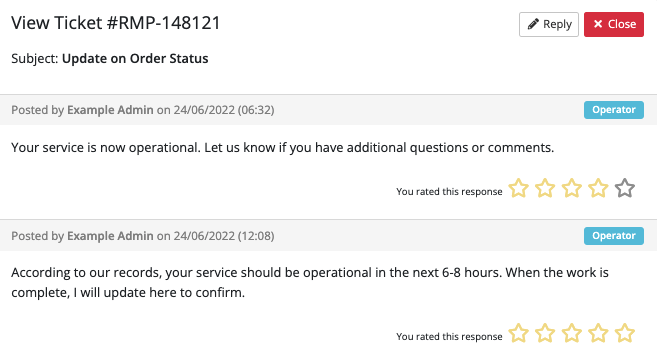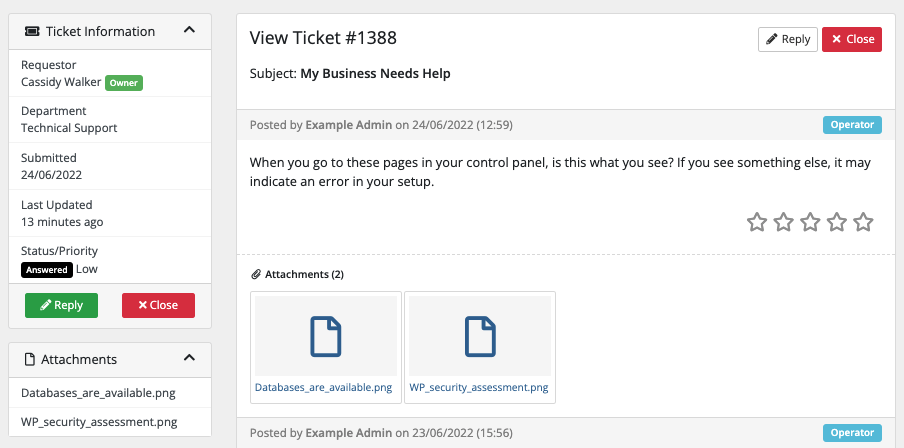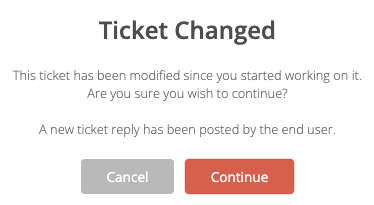Support Tickets
The Support Ticket system is a fully featured ticket desk that allows you to handle all communication with your clients. It features threaded discussions, private notes, ticket flagging, varying priority levels, and automatic inactive ticket closure. You can assign Admins to specific departments, so that they only have access to their designated areas.
Contents
- 1 The Ticket List
- 2 Merging Tickets
- 3 Splitting Replies
- 4 Admin Notes
- 5 Changing Associated Service
- 6 View Security Question
- 7 Custom Fields
- 8 Options
- 9 Ticket Tags/Tag Cloud
- 10 Log
- 11 Opening a New Ticket
- 12 Automated Knowledgebase Article Suggestions
- 13 Ticket Reply Ratings
- 14 Feedback Request
- 15 Auto Closing
- 16 Automated Escalations
- 17 Allowed File Attachments
- 18 Ticket Watchers
- 19 Ticket Collision Detection
The Ticket List
When a client submits a support ticket the appropriate members of staff assigned to that department will receive a New Support Ticket Opened email. To view the ticket, navigate to Support > Support Tickets.
This page displays all tickets that are in the Awaiting Reply status by default. The ticket order can be changed by clicking the table headings. To view only those tickets with a certain status, department or to search click the Search/Filter tab. The most-commonly-used status lists can accessed directly via Support in the navigation bar.
The Auto Refresh feature reloads the ticket list automatically at frequencies ranging from every 1 minute to 15 minutes. This is configured via the Auto Refresh tab.
There are several bulk tools on this page.
- Click Close to close tickets.
- Click Delete to delete tickets.
- Click Merge to merge two tickets, with the older ticket merging into the newer ticket.
- Click Block Sender & Delete to delete tickets and add the sender's email to the Banned Emails list.
A ticket starts in the Open status. This indicates that the client has not yet received a reply from a member of staff. After a reply, the status automatically changes to Answered.
The status can also be changed manually from the view ticket screen, using the dropdown menu next to the ticket subject. A change in selection here is saved immediately using AJAX, without needing to reload the page. Custom statuses can also be created to help with management of tickets. See the Support Ticket Statuses section for more information.
Merging Tickets
When using Merge:
- A ticket will always merge into the earliest-opened ticket. This is the one with the lowest ID in the database. This is the same whether you merge from inside of a ticket or from the ticket list.
- Unless it already appears in the subject, the subject of the ticket will have [MERGED] appended in the client's language.
- The ticket status will take the status from the ticket that has received the latest reply.
- A ticket that has been merged into another ticket will not appear in the ticket list, but accessing an old ticket URL will redirect to the appropriate ticket.
- Replying to an old ticket via email will also redirect the reply to the appropriate ticket after the merge.
- If you are merging tickets from multiple clients together, the client that had the oldest ticket would see the merged ticket in their client area.
Splitting Replies
Sometimes it may be necessary to move specific replies out from one support ticket and into a new one. If the message contains an attachment, this will be carried across into the new ticket too.
To do this:
- Check the checkboxes in the top-right corner of the messages you wish to split into a new ticket.
- Scroll to the bottom of the page and click Split Selected Replies.
- In the prompt that appears, select a department, priority, and subject for the new ticket, and whether to send a new ticket notification.
- Click Submit.
To quickly return to the original ticket, click Other Tickets.
Admin Notes
The Add Note tab allows private staff-only messages to be recorded against a ticket. Clicking the tab provides a new text area to enter the note. When you submit it, will add the note and display it to all other admins viewing the ticket along with the staff member's name and date and time. Customers do not get any notification of notes being added and cannot see them.
Staff Mentions
Staff mentions allow you to "tag" other administrative users and trigger an email notification to them as a quick and easy way to alert them to the note you have just added. To use a staff tag in a ticket note, just type the @ followed by the staff member's name.
For more information, see Staff Mentions.
Changing Associated Service
A client opening a ticket can select a related service, which will be highlighted when viewing the ticket via the admin area. Click Change Associated Service to change the service that a ticket is associated with. This is useful when a client doesn't choose a service when opening the ticket, or if a client chooses the wrong service. A change of associated service will be logged to the ticket log so all changes can be seen.
When clicking Change Associated Service, an AJAX call will fetch, if appropriate, the remaining services for a client if they aren't all displayed. If an admin user is already viewing all the services of a client on a ticket, an AJAX call will not take place.
View Security Question
WHMCS 8.0
We added View Security Question in WHMCS 8.0.
To access a user's security question information, click View Security Question in the top-right corner of their reply to the ticket. This allows you to view, but not change, the user's Security Question and Security Answer.
If the user has not configured a question and answer at Hello, Name! > Security Settings in the Client Area, View Security Question will not display in their replies. Users cannot configure security questions until you add one or more questions at Configuration () > System Settings > Security Questions.
Custom Fields
You can set up custom fields for support departments on a per department basis. Use this to suit a given department's specific needs. These fields display on the Custom Fields tab within the ticket.
Options
The Options tab allows the attributes of the ticket to be modified. The department, subject, status, and priority can all be changed.
Sometimes it may be useful for additional people to receive copies of the email messages in this ticket. To do this, enter their email addresses in the CC Recepients field. Multiple recipients can be entered in a comma separated list (for example, jeff@example.com,bob@example.com).
To change the client a ticket is assigned to, adjust the Client ID. If the client's name, company, or email address is known, start typing this into the field. An AJAX list of the search results will appear. Click the appropriate client from the list to automatically fill in their Client ID.
When two tickets are merged, the messages from both tickets will be arranged chronologically. In Merge Ticket, enter the Ticket ID of the ticket to be combined. The newer ticket is merged into the older ticket.
Flagging a ticket to another admin is useful if you want to bring the ticket to the attention of another staff member. Flagged tickets appear in a separate section at the top of the support ticket page to ensure they stand out from the main queue. The Support Ticket Flagged email will also be sent to the user. Flagging a ticket to oneself will not send the email.
Ticket Tags/Tag Cloud
Ticket Tags/Tag Cloud is designed to link tickets that have a common item (for example, tickets that all report the same issue). You could use this to save a case ID from an external system (for example, if you wish to follow up with those tickets once it is marked as resolved). To find all the tickets linked to the tag, use the same name for the tag and then search by tag from Search/Filter. It should bring up the list of tickets linked to the tag.
Log
The ticket log displays an audit trail of all the actions applied to this ticket. This includes department changes, tickets flaggings, adding of notes, changes of ownership, and status changes.
Opening a New Ticket
Staff can open support tickets from within the administration area by navigating to Support > Open New Ticket. There, enter the details of the recipient.
- If they are not a client, fill their name in the To field and the Email Address field.
- If they are a client, use the Client Search field to search by name, company, and email addresses. Clicking the client's name will automatically fill in the recipient's details.
If the client has contacts or sub-accounts configured, a Contacts menu will appear. If you wish the ticket message to be emailed to the contact, select their name from the menu. Select None to deliver it to the master account.
Automated Knowledgebase Article Suggestions
As a user enters a message for submission as a support ticket, WHMCS can lookup and display relevant articles that match keywords in the submission text. This can provide an answer to a user without them needing to ever submit the ticket. This is designed to help reduce common support questions. To enable or disable this, use Knowledgebase Suggestions in the Support tab at Configuration () > System Settings > General Settings or, prior to WHMCS 8.0, Setup > General Settings.
You will need at least 5 articles with 30 words in each before the suggestions start working. This uses MySQL full text searching for matches.
Ticket Reply Ratings
Ticket reply ratings allow your customers to rate responses they receive on tickets in the ticket system. They also allow you to monitor customers' reactions to the support they receive from your staff. To enable the ticket rating feature, go to the Support tab at Configuration () > System Settings > General Settings or, prior to WHMCS 8.0, Setup > General Settings. Then, check Support Ticket Ratings.
When enabled, each reply in the client area will show a row of stars for the user to choose from in rating the response. They range from 1 being poor to 5 being excellent. Rating a reply is optional, so not every reply will get a rating. Ratings display when viewing the ticket in the admin area and there is also a report in the Reporting section that allows you to monitor these ratings:
Ticket Ratings Reviewer allows you to filter based on specific star ratings and within a given date range.
Feedback Request
The location of this functionality was changed in WHMCS 7.0.
In WHMCS 7.0 and later, you can enable emails requesting a user to provide feedback for their support ticket experience on a per-department basis. On upgrading to WHMCS 7.0, if you have enabled Ticket Feedback, it will be enabled by default for all existing departments. If you do not have it enabled, it will not be enabled for any departments automatically.
Feedback Request determines whether an email request will be sent for a user to provide feedback for their support ticket experience. The results of the feedback emails can be reviewed via the Ticket Feedback Scores and Ticket Feedback Comments reports.
Auto Closing
This feature allows you to have support tickets automatically closed after a certain time of inactivity has passed. This only closes tickets set to Open or Answered. Tickets set to On Hold or In Progress are not closed.
To set the length of time of inactivity before closure, go to Support Ticket Settings at Configuration () > System Settings > Automation Settings or, prior to WHMCS 8.0, Setup > Automation Settings. Then, enter the time in hours (for example, 48 indicates two days) in Close Inactive Tickets.
When closing the ticket, WHMCS sends a Support Ticket Auto Close Notification email to the user. You can customise that email in Configuration () > System Settings > Email Templates or, prior to WHMCS 8.0, Setup > Email Templates.
Automated Escalations
The status, department, and priority of a ticket can be changed automatically after a set time. For more information, see Support Ticket Escalations.
Allowed File Attachments
Support tickets and replies allow a file to be uploaded if the user needs to send you something or if you need to send the user something.
To configure the list of allowed file types, go to the Support tab at Configuration () > System Settings > General Settings or, prior to WHMCS 8.0, Setup > General Settings. By default, the allowed file types are:
- Image files (.jpg, .gif, .jpeg, and .png)
- .zip
You can add additional types by adding them to the allowed extensions field in a comma-separated list. It is not possible to allow the user to upload PHP files due to the security risks this creates.
Note
The file upload restrictions do not apply to admin users and an admin user can attach any type of file to a ticket.
Ticket Attachments
Thumbnail previews of image attachments display beneath the ticket message if you enable them in the Support tab at Configuration () > System Settings > General Settings or, prior to WHMCS 8.0, Setup > General Settings.
Note
Ticket attachments will not be forwarded to staff members in notification emails. This is to prevent potentially sensitive attachments being re-transmitted via email and reduce email bandwidth consumption.
Ticket Watchers
Any admin-level user with access to view a support ticket can watch the ticket. Watching a ticket subscribes the admin user to email notifications of any replies, notes, or changes to the ticket options.
To watch a ticket, click Watch Ticket in the admin area ticket sidebar.
An email notification be generated for any of the following actions:
- A client or user posting a reply.
- Another admin user posting a reply.
- Another admin user posting a ticket note.
- A change of ticket options by another admin user.
- A ticket being assigned to your admin user.
- A closure of the ticket by the client or user.
For a full overview of support ticket notifications, including ticket watcher notifications, see Ticket Notifications.
An admin user can unsubscribe from receiving notifications for a ticket at any time by clicking Unwatch Ticket. This is only visible in tickets that the admin user is currently watching.
Ticket Collision Detection
Collision detection prevents you from replying to a ticket or making changes when the status of a ticket has changed since you originally opened it.
Example
You open the ticket at 10:45am. You begin to type a reply but, before you finish, you become distracted. You return to the ticket 15 minutes later. You submit your reply, not realising that, in the lapsed time, another member of staff has already replied to the ticket. The collision detection will alert you to this before sending the reply to the customer, avoiding the confusing extra reply.
You will receive a warning message if any changes have been made to a ticket when performing any of the following actions:
- Change of department.
- Change of assignment or flagged user.
- Change of priority.
- Change of status.
- Submitting a reply.
- Making a change to the ticket options.
The alert you receive will provide details about what has changed and ask you to confirm whether you wish to continue.
The following attributes of a ticket will trigger a collision detection warning:
- Department
- Ticket Subject
- Ticket Priority
- Assigned Client
- Assigned Admin User
- CC Recipients
- Last Reply Time
- Ticket Status






